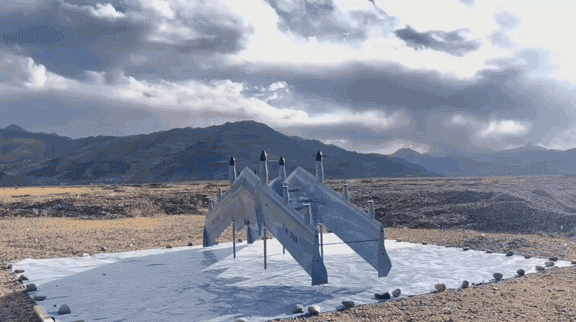Fixed Wing VTOL Drones in Disaster Response: Rapid, Reliable, and Ready for Action
When disasters strike—earthquakes, hurricanes, floods—minutes can determine survival. Yet ground teams face blocked roads, while conventional aircraft require runways. That’s where Fixed Wing VTOL Drones revolutionize the field. These hybrid UAVs combine vertical takeoff and landing (VTOL) capability with long-endurance fixed-wing flight, enabling rapid deployment and wide-area coverage in even the harshest environments.
This article explores how Fixed Wing VTOL Drones reshape disaster response, highlighting innovations from CHANG CHUN CHANG GUANG BO XIANG UAV Co., Ltd., a pioneer in dual fixed-wing VTOL UAV systems.
1. UAVs: Essential Tools for Modern Disaster Relief
Unmanned Aerial Vehicles (UAVs) have become indispensable in emergency operations. Equipped with advanced sensors and cameras, drones can quickly map affected areas, assess damage, locate survivors, and deliver critical supplies.
However, traditional multirotor drones face challenges: limited endurance, reduced range, and high energy consumption. These constraints led to the rise of Fixed Wing VTOL Drones, which merge endurance with flexibility—ideal for fast-changing disaster zones.
2. From Multirotor to Hybrid Evolution
Multirotor drones hover precisely and maneuver with agility but lack endurance. In contrast, fixed-wing aircraft fly efficiently over long distances but need runways.
Fixed Wing VTOL Drones bridge this gap. They take off vertically from confined spaces, transition seamlessly to horizontal flight, and cover vast areas with fuel-efficient performance—offering the best of both designs.
3. Why Vertical Takeoff Matters in Disaster Zones
In disaster-stricken regions, runways are often destroyed or inaccessible. VTOL capability enables takeoff and landing from rooftops, narrow roads, or forest clearings—critical flexibility for time-sensitive missions. This makes Fixed Wing VTOL Drones the most adaptable solution for emergency responders.
4. Core Advantages of Fixed Wing VTOL Drone Technology
5. CHANG CHUN CHANG GUANG BO XIANG UAV’s Dual Fixed-Wing VTOL Strengths
BO XIANG’s Dual Fixed-Wing VTOL UAVs stand apart with a dual-wing + multi-rotor layout, combining aerodynamic lift with vertical thrust. This design enhances control, stability, and flight efficiency under adverse conditions.
Models: Wingspans from 1.59 m to 5.94 m
Payloads: Up to 200 kg
Endurance: Up to 8 hours per flight
Certifications: CAAC (China) special airworthiness certification for TW50 & TW200
With over 1 million verified flight hours, BOXIANG’s UAVs deliver proven performance and safety reliability.
6. Smart Control & Autonomy
BOXIANG UAVs feature advanced autonomy and safety systems:
Automatic Return-to-Home (RTH)
GNSS anomaly compensation
Low-battery and fail-safe protocols
Real-time health monitoring
These ensure safe, intelligent operations even in unpredictable field conditions.
7. Real-World Applications in Disaster Response
A. Wide-Area Mapping & Reconnaissance
BOXIANG drones use RTK positioning (1 cm + 1 ppm) and LiDAR to create high-resolution orthomosaics and 3D terrain models for damage evaluation.
B. Emergency Communication Relays
Acting as airborne nodes, these drones can re-establish communications between rescue teams when ground networks fail.
C. Medical & Supply Delivery
Fixed Wing VTOL Drones can hover or land vertically for precision drop-offs, delivering vital medicines and supplies to inaccessible regions.
D. Thermal & Infrared Search Operations
EO/IR gimbals detect heat signatures of survivors under debris or vegetation, accelerating rescue efforts.
8. Mission Workflow: From Preparation to Operation
BOXIANG’s systems support multi-UAV swarm coordination, enabling simultaneous mapping and communication relay for large-scale disaster zones.
9. Challenges and Future Development
Despite breakthroughs, challenges remain:
Airspace regulations: Coordinating with manned aircraft in emergency zones
Energy limitations: Vertical takeoff consumes significant power
Payload-endurance trade-offs: Heavier loads reduce range
The next frontier lies in AI-powered swarm coordination, hybrid propulsion, and onboard edge computing for real-time decision-making and analytics.
10. Conclusion: A New Standard for Disaster Response
Fixed Wing VTOL Drones are redefining disaster operations by combining the range of fixed-wings with the versatility of VTOL systems.
CHANG CHUN CHANG GUANG BO XIANG UAV’s dual-wing, full-vector, and high-payload systems demonstrate unmatched reliability and efficiency in crisis response.
Governments and relief agencies should embrace this technology through training, regulatory support, and fleet coordination—ensuring that no disaster zone remains out of reach.
FAQs About Fixed Wing VTOL Drones
Q1: Why not use traditional multirotor drones?
They offer precision but suffer from limited range and endurance—insufficient for large-scale disaster mapping.
Q2: What differentiates a Fixed Wing VTOL Drone from a Tilt-Rotor model?
Fixed-wing VTOLs transition smoothly without complex rotor pivot mechanisms, improving durability and payload capacity.
Q3: How quickly can BOXIANG’s systems be deployed?
With modular components and one-click launch functions, deployment can occur within minutes.
Q4: Can these drones operate in strong winds?
Yes, the dual-wing and vector-control design provides superior wind resistance and stable flight performance.
Q5: What’s next for Fixed Wing VTOL Drone technology?
Expect AI integration, hybrid propulsion, and enhanced autonomy for smarter, longer, and safer missions.

